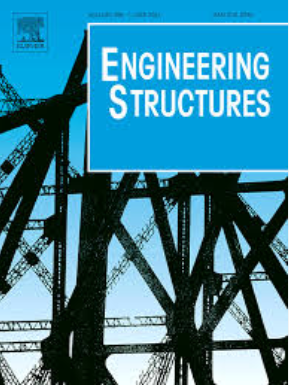Full-scale shake table testing method for seismic assessment of nonstructural elements using a universal testbed and a standard building-specific loading protocol
IF 6.4
1区 工程技术
Q1 ENGINEERING, CIVIL
引用次数: 0
Abstract
Nonstructural elements play a pivotal role in maintaining the functionality of buildings, making their seismic resilience a critical focus in research and engineering practices in the past few decades. A building-specific standardized assessment procedure is implemented to evaluate the seismic performance of nonstructural elements in a building, considering the specific seismic risks. Time history analyses of a tall building subjected to a series of design spectrum-compatible ground motions demonstrated the necessity of building-specific considerations in standard testing. Consequently, a standard loading protocol accounting for the dynamic characteristics of the archetype building was established. This study further extends the protocol to enable testing of two adjacent floors of the archetype building through Nonstructural Element Simulator on Shake Table (NEST). The universal testbed, NEST, was employed to replicate boundary and load conditions representative of real-world scenarios for multiple nonstructural elements. A nonlinear control algorithm that enables the NEST testbed to reproduce the proposed loading protocol accurately was developed in the numerical domain. Full-scale shake table tests validated the proposed method, demonstrating its capability to replicate the building-specific loading protocol with errors below 30 %. The experimental results showed that the contents sustained varying degrees of damage under the design-basis earthquake in the archetype tall building. Additionally, the proposed loading protocol proved effective in identifying the sensitive frequency component of the contents.
非结构构件地震评估的全尺寸振动台试验方法,使用通用试验台和标准建筑特定荷载协议
非结构构件在维持建筑物的功能方面起着关键作用,使其抗震能力成为过去几十年研究和工程实践的关键焦点。在考虑特定地震风险的情况下,对建筑物非结构构件的抗震性能进行了标准化评估。对某高层建筑在一系列设计谱兼容地面运动作用下的时程分析表明,在标准测试中必须考虑建筑的特殊性。因此,建立了考虑原型建筑动力特性的标准加载协议。本研究进一步扩展了该协议,以便通过振动台非结构单元模拟器(NEST)对原型建筑的两个相邻楼层进行测试。通用测试平台NEST用于复制代表多个非结构元件实际场景的边界和载荷条件。在数值领域提出了一种非线性控制算法,使NEST试验台能够准确地再现所提出的加载协议。全尺寸振动台试验验证了所提出的方法,证明其能够复制建筑物特定加载协议,误差低于30% %。试验结果表明,在设计基准地震作用下,原型高层建筑的构件承受了不同程度的破坏。此外,所提出的加载方案在识别内容物的敏感频率分量方面是有效的。
本文章由计算机程序翻译,如有差异,请以英文原文为准。
求助全文
约1分钟内获得全文
求助全文
来源期刊

Engineering Structures
工程技术-工程:土木
CiteScore
10.20
自引率
14.50%
发文量
1385
审稿时长
67 days
期刊介绍:
Engineering Structures provides a forum for a broad blend of scientific and technical papers to reflect the evolving needs of the structural engineering and structural mechanics communities. Particularly welcome are contributions dealing with applications of structural engineering and mechanics principles in all areas of technology. The journal aspires to a broad and integrated coverage of the effects of dynamic loadings and of the modelling techniques whereby the structural response to these loadings may be computed.
The scope of Engineering Structures encompasses, but is not restricted to, the following areas: infrastructure engineering; earthquake engineering; structure-fluid-soil interaction; wind engineering; fire engineering; blast engineering; structural reliability/stability; life assessment/integrity; structural health monitoring; multi-hazard engineering; structural dynamics; optimization; expert systems; experimental modelling; performance-based design; multiscale analysis; value engineering.
Topics of interest include: tall buildings; innovative structures; environmentally responsive structures; bridges; stadiums; commercial and public buildings; transmission towers; television and telecommunication masts; foldable structures; cooling towers; plates and shells; suspension structures; protective structures; smart structures; nuclear reactors; dams; pressure vessels; pipelines; tunnels.
Engineering Structures also publishes review articles, short communications and discussions, book reviews, and a diary on international events related to any aspect of structural engineering.
 求助内容:
求助内容: 应助结果提醒方式:
应助结果提醒方式:


